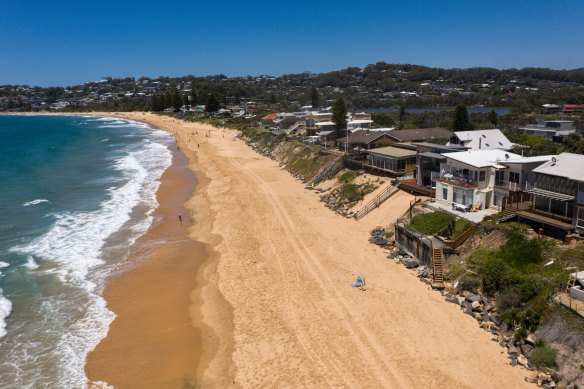
Making matters worse is climate change. Wave sizes and sea levels will increase as oceans continue to warm, causing greater damage to beaches. The coastline around Sydney is expected to experience between 20 centimetres and just over a metre of sea level rise in the next seven decades. This means the state’s coastline is expected to change significantly.
Harley said Australian beaches are very dynamic and tend to fluctuate depending on the season.
In usual summer months, waves move from a south or south-east direction. This typically means the northern end of the beach gets narrower and the southern ends get larger.
But during La Nina events, they shift slightly anti-clockwise and are more easterly, which leads to a higher risk of erosion on the beach, particularly over the summer. It can also cause “beach rotation” – where the beach realigns itself to the prevailing wind direction. Waves can tend to be slightly bigger than normal.
A La Nina event occurs when trade winds are stronger than usual, and a warm patch, where air is more likely to rise and create clouds and rain, is pushed closer to Australia. That typically translates to above-average rain in winter and spring for eastern Australia.
Loading
What’s been particularly interesting about this year’s La Nina event is inlets and lagoons that would typically feed water into the ocean were inundated, and have swallowed the beach from behind, Harley said. In some locations, this means beaches have been attacked from all sides.
Harley said after three years of back-to-back La Nina events, only some parts of the NSW coastline have recovered quickly. As a rule of thumb, it takes between five and 10 days for every metre of sand from the shoreline to return to the beach. Recovery can sometimes take months if beaches lose up to 40 metres of sand.
While many beaches have suffered during the past three years, meteorologists forecast the return of El Nino in coming months, meaning warmer and drier conditions.
“We would be worried if there was another La Nina event because it would further strip beaches of sand and they would be more vulnerable to damage. But the good news is that La Nina is looking to weaken,” Harley said. “We might see some respite [next year] and we should in theory see the beaches recover again.”

Some NSW beaches have suffered severe erosion over the past three years because of La Nina.Credit:Nick Moir
While the weakening of La Nina will allow beaches to recover, it also provides an opportunity for communities to do much-needed mitigation work. This week, the NSW government announced $6.7 million in grants to help them.
Minister for Local Government Wendy Tuckerman said seven councils will receive funding for 13 projects to better manage coastal erosion, protect wetlands and manage estuaries.
“A significant project identified for funding in this round includes a $2.3 million investment in structures at Stockton Beach to address immediate erosion risk,” she said. “Other grants will help ensure that the ecological values of NSW coastal, wetland and littoral rainforest areas are protected, while accommodating public access, amenity and recreation where appropriate.”
Loading
This includes stabilising and revegetating dunes in the Shoalhaven area, bank stabilisation along the Georges River at Deepwater Park, and improving water quality and ecosystem health in the Manning River estuary.
But Harley said more funding from state and federal governments was needed to adequately prepare and protect communities, as well as ensure future development in those areas is done with ample consultation and consideration for the changing coastlines. Over the next 50 years, the Insurance Council of Australia has estimated governments will need to invest at least $30 billion in coastal protection and adaptation projects.
Get to the heart of what’s happening with climate change and the environment. Our fortnightly Environment newsletter brings you the news, the issues and the solutions. Sign up here.









 Add Category
Add Category